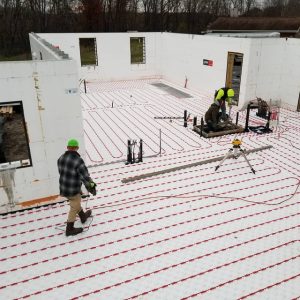Deicing chemicals leave stains on footwear, irritate pets’ paws, and corrode vehicles. But did you know that they also have a lasting impact on the surrounding ecosystems?
In this post, we’ll examine the environmental effect of deicing chemicals and compare it to the carbon footprint left by Snow and Ice Melting (SIM) systems.
How Deicing Chemicals Affect the Environment
We may call it “deicing salt,” but nowadays there’s actually a number of different chemicals used to keep surfaces clear of snow and ice. All of them have an impact on the surrounding environment in one way or another. Below, we’ll take a look at how common deicing chemicals affect our ecosystems.
Chloride Deicers
Chloride-based deicers are the least expensive, and are used extensively throughout the US and Canada. This deicer family includes Sodium Chloride, Magnesium Chloride, and Calcium Chloride.
Chloride Element in Chloride-Based Deicers
The chloride element of these deicers is highly mobile, not biodegradable, and doesn’t absorb well into soil or mineral surfaces. Because of these properties, it can travel far from the original deicing location (with stormwater, for example), and affect any ecosystems it encounters along the way.
In soil, chloride impairs water absorption, a process that contributes to erosion, as runoff water continues its way down unimpeded, picking up sediment along the way.
This inability to absorb water properly is also harmful for agriculture, as it causes irrigation to be less effective.
Chloride also affects surrounding vegetation, leading to symptoms that resemble those caused by drought — brown foliage, stunted growth, and dying limbs.
In water, chloride has proven to be harmful to various forms of aquatic organisms.

Sodium, Magnesium, and Calcium in Chloride-Based Deicers
The sodium, magnesium, and calcium elements present in various forms of chloride deicers have their own ways of impacting the environment, too.
For example, sodium ions can alter the structure of the soil, decreasing its permeability and infiltration. Again, this means that soil’s ability to absorb water is reduced — a harmful outcome for both erosion control and vegetation growth.
Sodium can also reduce the presence of calcium, magnesium, and other beneficial elements in soil by raising the soil’s alkalinity.
In contrast, calcium and magnesium can actually benefit the soil’s structure and improve drainage.
In groundwater, these chemicals have an effect on the hardness of water. For example, higher levels of sodium translate into softer water, whereas elevated levels of calcium contribute to water hardness.
Acetate Deicers
Acetate deicers, such as Calcium Magnesium Acetate (CMA), consume oxygen as they degrade. This is a significant concern for aquatic ecosystems, where various organisms can perish if the water they inhabit is starved of oxygen.
In soil, acetates have shown a tendency to increase soil’s permeability substantially — up to 20 times in some test plots.

Don't miss a thing!
Subscribe for exclusive content, insider industry news and limited edition webcasts.
How Snow and Ice Melt Systems Impact the Environment
While deicing chemicals are harmful to a variety of ecosystems — notably aquatic life and soil — SIM systems don’t release any chemicals into the environment, apart from CO2. This carbon footprint is caused by the combustion process in the boiler, which burns natural gas to heat the water that circulates throughout a SIM system’s tubes.
Now, modern, condensing boilers are far more eco-friendly than their older, non-condensing ancestors, but they still do emit CO2 whenever they operate.
Below, we will calculate roughly how much CO2 gets released when a SIM system is operational.
Now, according to the US Energy Information Administration, roughly 116.65 pounds of CO2 are emitted when natural gas is used to produce 1,000,000 BTUs.
With this figure in mind, we can calculate how much CO2 a boiler with a heating output of 180,000 BTU/h will produce in a single hour:
116.56/(1,000,000/180,000) = 20.98
That’s roughly 21 pounds of CO2 per hour of operation. In comparison, a standard passenger vehicle emits approximately the same amount of carbon while driving 22 miles.

Wrapping It Up
Both deicing salts and SIM systems have an impact on the environment. Chemical deicing is harmful for soil and aquatic ecosystems, while the boilers used to power SIM systems emit CO2 into the atmosphere as they operate.
The good news, though, is that heating technologies such as boilers are always getting more efficient. What’s more, they’re gradually becoming compatible with clean energy generation methods, such as photovoltaic panels and hydrogen combustion. That’s why, in the long run, SIM systems will always be more eco-friendly than deicing chemicals.






